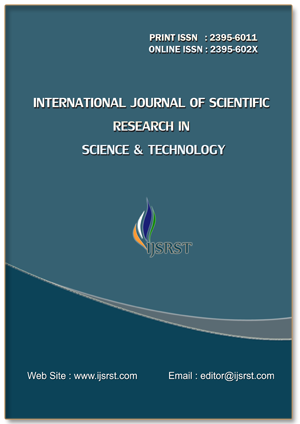Analysis of Phytochemical and Antioxidant Variation between Selected Phenophase of Raphanus sativus L. leaves
DOI:
https://doi.org/10.32628/IJSRST251222747Keywords:
Raphanus sativus L., Phytochemical analysis, Phenol, Flavonoids, Antioxidant AssayAbstract
The present study explores the Phytochemicals and Antioxidant activity variation between distinct phenophases, namely large leaves and microgreens, of Raphanus sativus L. Utilizing methanol and acetone solvents with spectrophotometric assays, we characterized the phytochemical profile of both Phenophases. Results revealed significant variations in phytochemical constituents in rich array of compounds including Phenol, Flavonoid, Carbohydrate, Saponin, Coumarin, Diterpene and Terpenoid. Notably absent were Alkaloids, Protein, Glycosides, Terpenes and lignin in any of the analyzed samples. Furthermore, our research delves that Microgreens and leaves have the highest TPC Concentration 5.19 ± 0.02 mg GAE/g and 4.91 ± 0.07 mg GAE/g in Acetone solvent respectively. The TFC concentration in Leaves with Acetone 0.72 ± 0.13 mg QE/g is maximum. Additionally, antioxidant potential was assessed through DPPH scavenging activity, it indicates that methanolic extracts exhibited greater antioxidant activity compared to acetone extracts, as evident by lower IC50 values indicating higher efficacy in neutralizing DPPH radicals. These findings underscore the importance of considering phenological stages in exploiting the nutritional and therapeutic potential of this agriculturally significant plant species.
📊 Article Downloads
References
Al-Shehbaz, I. A. (2011). Brassicaceae (mustard family). eLS.
Banu, K. S., & Cathrine, L. (2015). General techniques involved in phytochemical analysis. International journal of advanced research in chemical science, 2(4), 25-32.
Chen, Z., Bertin, R., & Froldi, G. (2013). EC50 estimation of antioxidant activity in DPPH assay using several statistical programs. Food chemistry, 138(1), 414-420.
El Mannoubi, I. (2023). Impact of different solvents on extraction yield, phenolic composition, in vitro antioxidant and antibacterial activities of deseeded Opuntia stricta fruit. Journal of Umm Al-Qura University for Applied Sciences, 1-9.
Gamba, M., Asllanaj, E., Raguindin, P. F., Glisic, M., Franco, O. H., Minder, B., ... & Muka, T. (2021). Nutritional and phytochemical characterization of radish (Raphanus sativus): A systematic review. Trends in Food Science & Technology, 113, 205-218.
Gutiérrez, R. M. P., & Perez, R. L. (2004). Raphanus sativus (Radish): their chemistry and biology. The scientific world journal, 4(1), 811-837.
Hanlon, P. R., & Barnes, D. M. (2011). Phytochemical composition and biological activity of 8 varieties of radish (Raphanus sativus L.) sprouts and mature taproots. Journal of Food Science, 76(1), C185-C192.
Lugasi, A., Blázovics, A., Hagymási, K., Kocsis, I., & Kéry, Á. (2005). Antioxidant effect of squeezed juice from black radish (Raphanus sativus L. var niger) in alimentary hyperlipidaemia in rats. Phytotherapy Research: An International Journal Devoted to Pharmacological and Toxicological Evaluation of Natural Product Derivatives, 19(7), 587-591.
Manivannan, A., Kim, J. H., Kim, D. S., Lee, E. S., & Lee, H. E. (2019). Deciphering the nutraceutical potential of Raphanus sativus—A comprehensive overview. Nutrients, 11(2), 402.
Murphy, C. J., Llort, K. F., & Pill, W. G. (2010). Factors affecting the growth of microgreen table beet. International journal of vegetable science, 16(3), 253-266.
Paradiso, V. M., & Renna, M. (Eds.). (2021). Ongoing Research on Microgreens: Nutritional Properties, Shelf-life, Sustainable Production, Innovative Growing and Processing Approaches. MDPI.
Quettier-Deleu, C., Gressier, B., Vasseur, J., Dine, T., Brunet, C., Luyckx, M., ... & Trotin, F. (2000). Phenolic compounds and antioxidant activities of buckwheat (Fagopyrum esculentum Moench) hulls and flour. Journal of ethnopharmacology, 72(1-2), 35-42.
Roghini, R., & Vijayalakshmi, K. (2018). Phytochemical screening, quantitative analysis of flavonoids and minerals in ethanolic extract of Citrus paradisi. International Journal of Pharmaceutical Sciences and Research, 9(11), 4859-4864.
Sembiring, E. N., Elya, B., & Sauriasari, R. (2018). Phytochemical screening, total flavonoid and total phenolic content and antioxidant activity of different parts of Caesalpinia bonduc (L.) Roxb. Pharmacognosy journal, 10(1).
Sethi, S., Joshi, A., Arora, B., Bhowmik, A., Sharma, R. R., & Kumar, P. (2020). Significance of FRAP, DPPH, and CUPRAC assays for antioxidant activity determination in apple fruit extracts. European Food Research and Technology, 246, 591-598.
Shaikh, J. R., & Patil, M. (2020). Qualitative tests for preliminary phytochemical screening: An overview. International Journal of Chemical Studies, 8(2), 603-608.
Shin, T., Ahn, M., Kim, G. O., & Park, S. U. (2015). Biological activity of various radish species. Oriental Pharmacy and Experimental Medicine, 15, 105-111.
Stankovic, M. S. (2011). Total phenolic content, flavonoid concentration and antioxidant activity of Marrubium peregrinum L. extracts. Kragujevac J Sci, 33(2011), 63-72.
Downloads
Published
Issue
Section
License
Copyright (c) 2025 International Journal of Scientific Research in Science and Technology

This work is licensed under a Creative Commons Attribution 4.0 International License.
https://creativecommons.org/licenses/by/4.0




